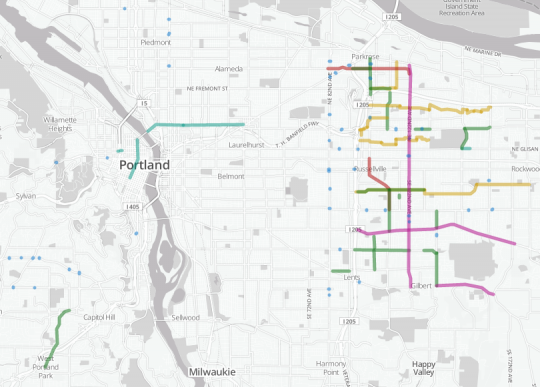
(Graphic by BikePortland using Transitmix.net. Click for an interactive version.)
So far, the public debate about a per-household and per-business street fee has been mostly about the costs: who would pay how much.
While that debate rages on, the city has finally floated some specifics about the possible benefits.
Above is a map of almost every project included in a so-called “straw man” list of street projects, to be completed over the first six years of the street fee, that would make it safer and more comfortable to bike and walk within Portland city limits. It’s based on a document circulated last week at the city’s Transportation Needs and Funding Advisory Committee.
“It’s our first attempt to try to tell people what we could be getting with this.”
— Dylan Rivera, PBOT spokesman
“It’s our first attempt to try to tell people what we could be getting with this,” city transportation spokesman Dylan Rivera said in an interview Tuesday.
We made this map using Transitmix.net, a new service designed for creating imaginary transit systems but also pretty good for mapping other street projects.
The map doesn’t include items that weren’t easily mappable, including $24 million in Safe Routes to School improvements throughout the city, $10 million for “ODOT partnerships” (presumably matching funds for improvements to state-owned city streets), and $5 million in unspecified sidewalk improvements around Southwest Portland. Nor does it include any neighborhood greenways that weren’t listed with cost estimates yet. (The neighborhood greenways section is already over budget.)
It also doesn’t include any of the maintenance and operations projects, mostly street paving, that the city says should comprise a bit more than half of a new street fee.
Of the 81 projects on the map above, 62 — about $39 million of the $61 million value here — would go in at or east of the street that formed part of Portland’s eastern border from 1910 until 1980: 82nd Avenue.
Almost half of the mapped money west of the Willamette River would go to one big project: a $10 million stretch of sidewalk along Capitol Highway between Multnomah Village and the West Portland neighborhood. Most of the rest would go to three protected bike lane projects in the central city: N/NE Broadway; part of the money (along with development fees) for a bike-walk bridge over I-405 at Flanders; and $3 million for one or more unspecified “central city” routes that we’ve mapped here, for the sake of visualization, as NW/SW Broadway from the bridge to Portland State.
Advertisement
East of 82nd, the single biggest line item is $8 million for “numerous projects” on 122nd including sidewalks, crossings and signalization changes — enough to improve the walking experience there and (the city speculates) persuade TriMet to bring the extremely popular 71 bus up to frequent service. It’s the only north-south transit line between I-205 and Gresham, a part of town where about a third of renters now live without cars.
Beyond that, the city’s straw-man list would bring East Portland:
- five new neighborhood greenways connecting to the 205 bike path
- sidewalks along Holgate, Ellis, Market, Halsey, Fremont, 102nd, 104th, 112th and 148th
- many improved crossings of 82nd, Sandy, 122nd and Division
- better street lighting along outer Powell and Foster
- extending the 102nd bike lane south around the bend to 112th (something the city categorizes for some reason as a “neighborhood greenway”
It’d be a huge investment in East Portland’s deeply incomplete street grid.
“The project list reflects a strong effort by equity advocates to ensure that the communities that have for too long been on the short end of the stick receive their due,” Jon Ostar of OPAL Environmental Justice Oregon wrote in an email Wednesday. Ostar credited Mychal Tetteh, CEO of the Community Cycling Center, as someone who’d provided “leadership” on the issue.
Mark Lear, the city’s street fee project manager, said in an interview Wednesday that the city’s current plan is for this six-year project map to be divided into two three-year lists, the first of which would (in a “best case” scenario) be approved by the city council, along with a citywide street fee, in November.
Want to get involved in changing or prioritizing the projects on this list? Now’s the time, Lear says. If you want to endorse any of these projects or any others, write him an email: mark.lear@portlandoregon.gov. Lear said he’d route messages to the appropriate staffer.
Bicycling advocate Lisa Marie White, co-chair of Bike Walk Vote, is organizing an “our streets happy hour” this Friday Sept. 5, 6:30 to 8 p.m. at the Waypost, 3120 N Williams Ave, to discuss the city’s comprehensive plan in general and where money should be invested in the short and long term.
“Here’s our chance to tell the city what we need,” White wrote in the Facebook invitation for the event.

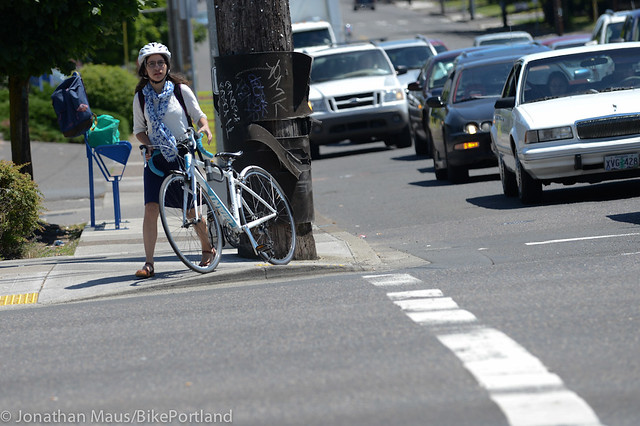
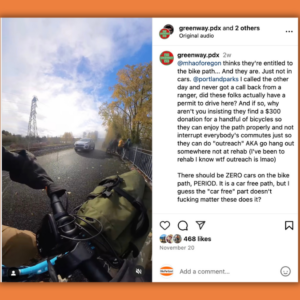
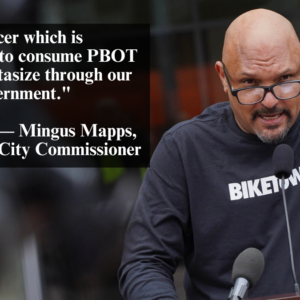

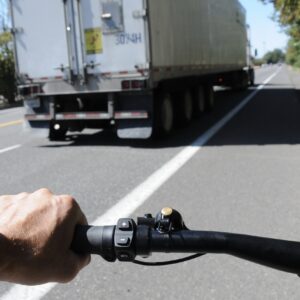
Thanks for reading.
BikePortland has served this community with independent community journalism since 2005. We rely on subscriptions from readers like you to survive. Your financial support is vital in keeping this valuable resource alive and well.
Please subscribe today to strengthen and expand our work.
It’s really striking to see it laid out like this. It draws attention to the fact that, for much of its run, 82nd Avenue is closer to the river than it is to Portland’s eastern border (despite once serving as that border, as you mention).
Is PBOT planning to finish the greenways it started a couple years ago before ‘funds dried up’?
The map is incorrect for the Capitol Hwy project in SW Portland – it is not just a sidewalk, but would also include bike lanes where none exist today. Also the project does not extend south of Barbur / I – 5. That segment of Cap Hwy already has bike lanes and sidewalks.
Also missing from the map is the critical safety improvement needed at many busy arterials citywide: improved crossings for cyclists, pedestrians and transit users…
OK I will correct my post – the crossing safety improvements are there if you use the interactive version and scroll to that specific feature. The map posted above is a bit deceptive.
Thanks, Roger – I wish we could have embedded the interactive version but that’s not possible yet. (Transitmix only launched last week.) As it is, the caption notes that the blue dots are crossing improvements.
Is this the city’s first acknowledgment of bike projects being paid for by the street fee?
Well, the fact that bike stuff would be involved has been public since early on. Novick and Hales just work very hard to not talk about it.
Protected bike lanes on SW/NW/N/NE Broadway thru downtown and the Lloyd district to Hollywood! There may not be much for bikes in the central city on this map, but this one project will be hugely helpful, if done right. We would use this all the time.
Done right is the key. Too many projects get watered down because of business complaints.
So I’m trying to do the math here. The fee is supposed to raise about $40M/year, meaning over the first six years $240M would be raised. Thus these projects ($60M) account for 25% of the whole fee. Does this sound right?
What I want to know is what is the *net* amount they think they’re going to raise. Let’s not forget the administrative cost to collect this money, never mind all the backroom calculations someone at the city is going to be performing to come up with customized versions of this flat fee for, well, some categories – right?
And are we expecting higher participation rates than with the Arts tax?
Sounds like they really are pushing to include it on our water bills (which is troubling as Fish has said that that is not a possibility).
I agree with your premise, collection is going to be a big issue.
How do they collect it in the other Oregon cities that levy a street fee?
That’s a great question. I think it varies (and some even (GASP) use a local gas tax).
Here in Oregon City, we have a “Pavement Maintenance” fee included on our water bill.
What? A single sidewalk project is all the city could come up with in SW Portland?? SW has the lowest sidewalk rate with just 33% (E Portland has 56%). If you take out downtown we are probably looking at 80-90% of streets without sidewalks. That means lots of busy but narrow streets with not more than a fogline for bicyclists and a goat trail (or ditch) for pedestrians. Examples are SW Vermont, Shattuck, Boones Ferry, Sunset, Capitol Hwy and so on. Not to speak of Barbur and Beaverton-Hillsdale hwy.
Building sidewalks in the hills (or anywhere really, but especially the hills) is an expensive project.
$10M for that piece? Wow. I grew up along that exact stretch, between Capitol Hwy & Multnomah (no village back then that I remember). I walked a mile (each way) along that shoulder to preschool in Multnomah. Those were the days.
The cost includes stormwater facilities. Nearby Woods creek and gets dumped from the runoff on Capitiol Highway.
The SW corridor planning has a lot of sidewalk improvement projects recommended in it through the whole area, and some of them are supposed to be expedited. So there’s almost certainly more coming. Where the funding will come from is another question though.
As we all know, most streets in SW will require a good bit of engineering due to the topography. Most eastern sidewalk projects area a bit more low hanging fruit (and thus a lot cheaper).
This is the great tragedy of post-war development around the country. The developers and initial home buyers in these areas saved money by not adding this infrastructure, and it is unfair to expect the general taxpayer to pay for these amenities.
Being able to get your workforce to work safely while allowing the free flow of goods… reducing the need for the single occupant auto seems a laudable goal. Build the second access to Swan Island.
If PBOT finds itself with the money to build a bridge over a freeway, I would rather they extended NE 7th over I-84 than NW Flanders over I-405. And I say this as someone who lives and works in NW.
I’d rather have both.
Tear out the east bank freeway/Marquam, reroute I-5 onto I-405, and then sell the prime waterfront real estate, using the money (billions of dollars) to pay for capping of I-405 and new bridges over I-84.
of course the word that means the most in this entire article is in the title….Might.
And might doesn’t mean much coming from city hall.
Wow, the equity focus is great! One corner of the city that may get forgotten is Brentwood-Darlington (B-D) in southern southeast Portland (southeast of Woodstock and west of Lents). B-D has many of the characteristics of East Portland (unpaved streets, few sidewalks, low incomes, annexed in the 80s). I think it could use some love (I’m two n’hoods away so I only go through there occasionally but I’m usually surprised by how bad the conditions are when I do).
I wouldn’t call this an equity focus. As was mentioned above, the total amount for the safety category is only around 25-30% of the total revenue spent. And, only about 50% of that 25-30% is going to be spent in East Portland (there’s lots of lines and dots but for the most part they’re pretty low budget projects).
If the amount of the maintenance allocation spent in East Portland isn’t significant, then this is another case where East Portland won’t recoup proportionately to what they put in – it’ll still be a donor area to the areas west of 82nd.
Bike Portland counts 64% ($39 million out of $61 million) of the safety dollars in East Portland if East Portland is defined as extending to 82nd throughout its length. I don’t know the numbers for sure, but I suspect East Portland would provide a good bit less than 64% of the street fee money. Providing a significantly higher percentage of the safety money to East Portland than East Portland is providing, due to East Portland being poorer, having worse traffic safety problems, and having been neglected by City investment in the past, sounds like equity to me. Am I missing something?
Certainly, the maintenance money needs to be equitably distributed for equity to be served overall. And how did we get from half-and-half maintenance vs. safety at the beginning of the street fee proposal to only 25-30% now? I must have missed that plot twist….
The discrepancy you guys are discussing comes mostly from the fact that $46 million of the $106 million in safety funds aren’t on the map above.
– $5 million over six years in SW sidewalks to be determined, not in the map but in the bar chart above
– $24 million over six years scattered throughout the city in Safe Routes expenditures to be determined, not on the map or the bar chart
– $20 million in miscellaneous projects that I couldn’t figure out how to map or that weren’t clearly for biking/walking improvements (center-lane rumble strips on Marine Drive, for example)
Sorry for the confusion. I’ve added a direct link to the city’s document to help clear this up.
OK, thanks for clarifying! I guess whether the safety money ends up being significantly East Portland-focused depends on whether a proportional portion of the remaining dollars gets allocated to East Portland. If none of it gets allocated to East Portland, then East Portland only gets mildly more than a proportional share of dollars (37.5% of dollars, 33% of population from generous assumptions below). If East Portland gets a proportional share of the remaining dollars, then it ends up with about 50% of the dollars (as you state, Cora), which is still enough more than East Portland’s population for me to call the overall allocation equity-focused.
I grabbed a map of population by neighborhood as of 2010. http://www.portlandonline.com/portlandplan/index.cfm?c=52257&a=288621 In 2010, EPNO had 24% of the City’s population. Let’s liberally round that up to 33% to add in areas between 82nd and I-205 north of Division that aren’t in EPNO and to account for greater population growth than in the City at large in East Portland since 2010. Let’s say that the remaining $41 million for citywide projects (excluding $5 million for SW sidewalks) is distributed proportional to population. That would add an additional $13.5 million to the $39 million identified for East Portland. Total would be $52.5 million, or 50.5% of the total – considerably greater the estimated 33% of population. That does depend on the Safe Routes and “other” money being distributed more or less proportionately to population.
I doubt it will be distributed proportionally, but let’s assume the best. This still only covers the portion of the street fee that is allocated for “Safety” projects.
There’s still the issue of the other allocations of the funding that will be directed to maintenance etc. Based on what is identified as a maintenance need – I highly doubt those funds will be equitably distributed.
I’ve been saying all along, you’d have to spend 100% of the safety money in East Portland to even come close to an equitable distribution of the total funding source.
Spending 100% of the money in East Portland is a great way to ensure that 100% of zero will be spend there.
“you’d have to spend 100% of the safety money in East Portland to even come close to an equitable distribution of the total funding source.”
Interesting. That was the same argument I was using over here for why the people who bike (now and might in future) on Foster should get a bigger slice now, since the car-bound on Foster had been getting pretty much the whole pie for the past 90 years.
http://bikeportland.org/2013/10/24/after-tempers-flare-citizen-committee-approves-pbots-plans-for-foster-96054#comment-4476079
I guess equity cuts both ways.
9watts, I think Cora is using a different argument which is that she believes that East Portland isn’t going to get a proportional share of the maintenance dollars. Because the maintenance dollars are (in the current proposal) a bigger pot than the safety dollars, East Portland could overall get less than it puts in.
I think this is more analogous to bike advocates wanting City funding in proportion to mode share than to bike advocates wanting a higher share of funding because of transportation investments having been historically heavily auto-centric at the expense of bikes.
I haven’t seen what’s identified as a maintenance need. Do you happen to know of a document somewhere?
Here’s the maps of the maintenance needs that’s somewhat equivalent to the safety straw man map.
http://www.portlandoregon.gov/transportation/65221
Thanks for sharing that link, Cora. The way it’s been explained to me is that generally speaking East and Southwest have greater safety needs because they were developed in the auto-oriented years, but the closer-in neighborhoods have worse pavement quality because their streets have been layercaked for so long on top of pre-automotive roads.
I hope to do more reporting on this subject, though. And there’s no question that East Portland has more dirt roads, though that’s not a huge share of the total street mileage.
On the “busy streets” map, East Portland seems almost even with the rest of the City in terms of City-identified maintenance needs. It’s in the “residential street” category that the City has identified less need in East Portland. I do wonder how that would change if unpaved streets and other streets that aren’t “up to City standards” for maintenance were included in the targets of this funding and in the maintenance list. I bet there are far more of those in East Portland than in other areas.
This map:
http://www.portlandoregon.gov/transportation/article/501610
of a straw-man 3-year maintenance project list makes East Portland look like it’s getting significantly less than inner southeast, but about as much or a little less than North and inner Northeast and Southwest? Hard to really tell without a list of how much money is proposed by area.
I think the “not up to city standards” is the crucial part here. In SW 66% of streets have no sidewalks, that means that 66% of the streets are not up to city standards and are mostly not maintained by the city, but by residents (except for major thoroughfares). That means that those 66% of streets don’t show up in the maintenance category. The inner eastside has a much higher proportion of city maintained streets and will thus get more maintenance dollars. Of course, I will have to continue to pay for the maintenance of our SW gravel road in addition to a street fee that my street does not benefit from. I will gladly pay for it when I get more sidewalks and bike facilities (on major streets) out of it, but it is still a double burden for residents.
Thanks for the shout Alex. Here in B-D we really struggle to connect with the city. As you point out we were “historically” part of east Portland (same annexation time and similar conditions), but are physically located in outer SE. So we often fall through the cracks, and makes it tough for our neighborhood to get any attention.
Surprisingly the bike access in B-D isn’t that bad, as we have bike lanes on a number of major streets (Duke, FLavel, 52nd) and have good access to the Springwater at a number of locations. Sidewalks, paved roads, curbs, etc is another story though. We desperately need better (or some) sidewalks next to all our schools and parks (even some city owned land here doesn’t have sidewalks and curbs in spots!!!!)
The B-D neighborhood is definitely going to fight for our piece of the pie out of the improvements that this fee may generate.
I hope people don’t get caught up in a narrow super-local view, demanding that their neighborhood gets its “fair share” of projects or gets its (fee) money’s worth. Increasing bicycling in Portland is a city wide need. The money should be spent where it will have the greatest effect. In many cases, I’d think that will be East Portland since taking bike facilities from nothing to something will be such a big change. In other cases, I can see spending money downtown or inner NE, to fill a key gap or complete a key connection in the existing bike route network. Some neighborhoods might contribute to the fee but get few/no new bike facility projects, because there aren’t such pressing needs. I hope the city, and we, take the bigger strategic view and not a parochial approach.
While I understand what you are saying, many in my neighborhood are viewing the street fee as a good place to kind of “take our stand” and demand the services infrastructure that we’ve somewhat been ignored (but have paid for) for the last 30 years.
I agree that a city is a “common good” type of situation, but after decades many are tired of the common good not being in their area.
The city doesn’t pay for sidewalks. The initial home builder does, and the existing homeowner pays to maintain them. If the sidewalk in front of your home gets damaged, you have to pay for it.
So I disagree on your point.
see: http://wweek.com/portland/article-17460-dirt_roads_dead_ends.html
“In a 2000 report to City Council about funding for street improvements, an expert panel delved into the history of Portland infrastructure. They called the notion that property owners have always borne the cost of paving streets a “long-standing myth.”
As recently as 2000, the study found, the city was paying most or all of the costs to pave many streets, especially in poorer neighborhoods.
“The implication of this myth was that property owners paid almost entirely for their street, a proposition that is nowhere near the truth,” the report says. “It is much more accurate, and also much more relevant to the problems we face today, to state that property owners have almost always helped pay for at least a portion of the costs for improving their streets.””
And even if you don’t believe this, we’re talking about at least at minimum CITY-OWNED property. The city should pay for sidewalks next to their own property.
A 2000 report found that there was a “long standing myth” that was untrue as recently as 2000? That doesn’t make any sense. Is there a copy of this report somewhere?
I’ve tried to get ahold of it, without any luck. I’m not surprised, as I can’t imagine this something the city or PBOT would want to be flaunting around. (I contacted WW, but the author has left).
I”m confused as to your confusion? The report was in 2000, so anything after it couldn’t be documented. But up until the report was put out the city was still subsidizing or paying for streets (as they have apparently been doing for a long time).
I don’t understand why the City would commission a report in 2000 to discover if they had ever made a routine habit of paying for street improvements, if they were paying for street improvements in 2000. If you can find this report, I would genuinely be interested in reading it. The city is normally very good about archiving these kinds of things on http://efiles.portlandoregon.gov.
To be clear, I think it’s terrible that there are arterial streets in this city without sidewalks. I think building those is a great use of street fee money. I think building a network of neighborhood greenways in East Portland is a great use of street fee money. But if people expect their cul-de-sac to be paved with money raised city-wide, then I do have a problem with that.
have you seen how our at large council system of government works? Clearly not all departments and officials are on the same page.
and we all know how much the city loves to do reports and studies.
I’m with davemess. These myths are useful in certain circles but that doesn’t make them true in all cases. I encountered a version of this same argument coming from BES staff on the history of our sewer system and who paid for what and why certain outcomes are the way they are.
http://bikeportland.org/2014/04/23/washington-county-commissioner-says-adjacent-landowners-should-help-pay-for-safety-projects-105038#comment-4751019
I’ve had similar interactions with BES folks. I’m not surprised, as I can’t imagine a lot of debate and rocking the boat in most city government departments.
Many parks in my neighborhood, which has developer-built sidewalks in front of every home, do not have sidewalks. If you get sidewalks in your neighborhood, I want them in mine as well…
how about your schools?